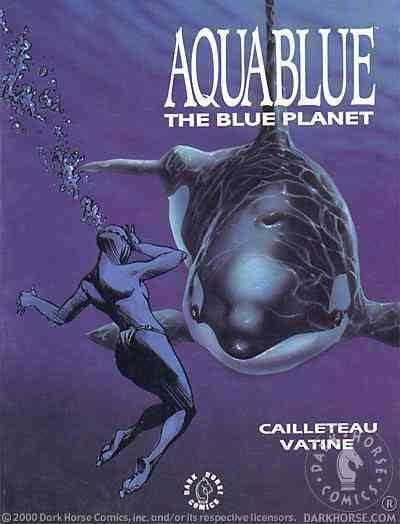Publisher Delcourt Genre Science fiction Originally published 1988 | Original language French Number of issues 11 | |
 | ||
Formats Original material for the series has been published as a set of graphic novels. Publication date April 1988 – November 2006 Illustrators Olivier Vatine, Thierry Cailleteau Similar Olivier Vatine books, Other books | ||
Aquablue is a French science fiction graphic novel by writer Thierry Cailleteau with several artists, Olivier Vatine (first volumes) and Ciro Tota (middle volumes) and Stéphane Brangier ('Siro', latest volumes). An adventure and military-based series, it also features ecological themes and criticism of colonial exploitation. Much of the series has been translated into German and parts into English.
Contents
Plot
Aquablue centers around the adventures of Wilfried Morgenstern, called Nao, young orphan and one of the sole survivors of the White Star cruise spaceliner wreck. Growing up on a space lifeboat with only Cybot (a simple but sentient and caring robotic nurse) to care for him, he eventually arrives on Aquablue, a planet almost totally covered by water. Arriving on the surface, Uruk-Uru - a gigantic manta ray-shaped whale - takes an interest in him before disappearing back into the depths of the sea.
Taken in by the primitive blue-skinned humanoid natives who see in him a messenger of their gods due to the visitation of Uruk-Uru, he grows up one of their own. Eventually he becomes a strong young man, skilled at swimming, diving and fishing to non-human levels, even though he does not have the gills and other water-adaptions the locals possess. His abilities, strength and ingenuity - as well as the friends he makes during his adventures - help him overcome the issues he faces during the series.
Aquablue - Volumes 1-5
Eventually, Nao's idyll is shattered shortly after his coming-of-age, when a terran company, 'Texec', supported by new colonial policies back on Earth, decides to use Aquablue as a location for special power plants feeding on the ocean's warmth. If they are not stopped, they will eventually cause the planet to glaciate and destroy the native life and culture.
With the help of his native friends, a repaired Cybot and some Terrans disillusioned by the ruthless colonial expansion, he decides to fight back at the intruders. However, they are guarded by a powerful mercenary army - the 'Brigades Morgenstern', owned and led by Nao's aunt, Ulla, who inherited billions from Nao's parents when they died on the White Star.
The original series chronicles the fight against the invaders, on Aquablue, in space and in the courtrooms of Earth, where Nao tries to regain his inheritance. Numerous setbacks occur, with Nao and the natives losing several major battles, but always eventually being rescued by new allies or their own skill and ingenuity.
The first four volumes were drawn by Vatine, before Tota took over in the last volume.
Aquablue II - Volumes 6-7
This short series, set after the conclusion of the fight for Aquablue (and not actually on the planet itself) chronicles the adventures of Nao and his friends as they discover the secret of why the White Star crashed in an asteroid field. Introducing a number of new settings in the Aquablue universe (which was previously mostly restricted to Earth and Aquablue), it also features a number of new point-of-view characters.
Aquablue Foundation - Volumes 8-(11)
After the original storyline is wrapped up by volume 7, Nao uses his inherited fortune to create the Aquablue Foundation, with the goal of stellar exploration and the protection of native societies and lifeforms. In one of the first volumes, he works to secure specimens of indigenous lifeforms before a stellar catastrophe destroys a remote planet. However, rich big-game hunters who've come to shoot trophies on the doomed planet soon cause problems.
Visual style
The series is drawn in the ligne claire style, though there are obvious changes with the different artists the series has had, with Tota's style being slightly more manga-inspired than the more realistic drawing of Vatine. Siro's style in the latest volumes is more reminiscent of Tota than of Vatine.
Awards
Aquablue received the Prix Jeunesse 9-12 ans (Youth Prize, 9-12 age category) at the Angoulême International Comics Festival in 1989.
In video games
In 2004, it was announced that game studio Kylotonn was developing an action-adventure video game for PC based on the comic. Entitled Aquablue: The Game, it was to be released 31 December 2004. Apparently, no finished game was ever produced, and the developer does not list it on its website (2007).
Avatar
The 2009 James Cameron movie Avatar bears a striking resemblance to many of the themes, ideas, character designs and overall look and feel of the Aquablue series.
